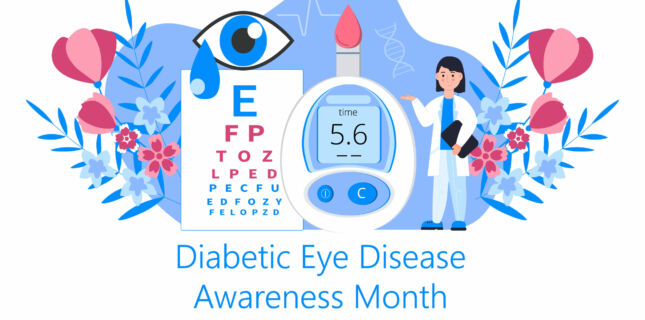
Diabetes + Vision
More than 30 million people in the U.S. have diabetes. This increases their risk for vision loss and blindness from diabetic-related eye diseases such as diabetic retinopathy. People with diabetes are also at higher risk for diabetic macular edema, cataract, and glaucoma.
Tip: Patient education materials available at shopdiabetes.org include posters, content for online posts, in-office videos, and pamphlets.
The Challenges
The longer a person has the disease, the greater their risk for eye disease. The good news, however, is that early detection and treatment can lower the risk of blindness by 95%. And managing diabetes—with diet, exercise, and medication—is the best way for diabetics to lower the likelihood of vision loss.
The biggest challenge is that 25% of the 30 million Americans who already have diabetes don’t even know it. And, according to the Centers for Disease Control and Prevention (CDC), another 86 million Americans are prediabetic. Sadly, only 10% of those individuals are aware of that.
The Future
By 2050, nearly a third of Americans under age 50 are expected to be diabetic or prediabetic.
Looking ahead, the picture is even more grim. That’s because by 2050, the Centers for Disease Control and Prevention (CDC) predicts that nearly a third of Americans under age 50 are expected to be diabetic or prediabetic. As reported in the United Kingdom Prospective Diabetes Study, by the time those folks are diagnosed, they will have already likely lost nearly half of their insulin-producing pancreatic beta cell function.
The Facts
To better help your patients, here are a few facts you and staff should know about the prevalence of diabetes in the U.S. and why it’s so important to not only treat but also educate patients.
• SPEND. 1 out of every 7 health care dollars in the U.S. are spent on treating diabetes and its complications, according to the American Diabetes Association (ADA).
• ETHNICITY: “Hispanics and African Americans are more than 50% more likely to suffer from diabetes than non-Hispanic whites,” reports the ADA.
• YOUTH: According to research of youth under age 18 conducted over a 10-year period and appearing in The New England Journal of Medicine, the number of newly diagnosed Type 1 diabetes cases increased 1.8% each year of the study, while the incidence of Type 2 rose 4.8%.
• RESPONSIBILITY: According to the American Optometric Association, optometrists have many responsibilities when it comes to caring for diabetic patients. They include: “Identifying diabetes’ tell-tale markers and reducing the risk of vision loss through timely diagnosis, intervention and action; improving the quality of care for people with diabetes; educating patients and care providers regarding ocular complications of diabetes, and the benefits of vision rehabilitation; and, suggesting vision rehabilitation services or referral of people with vision loss from diabetes.”
The Resources
Where can you get info to share with patients? A plethora of materials are available at shopdiabetes.org, including posters and content for online posts to in-office videos and patient education pamphlets.
How do you educate families in your practice about the prevention and treatment of diabetes? Tell us and share in the conversation on Facebook here.
Comments are closed.









